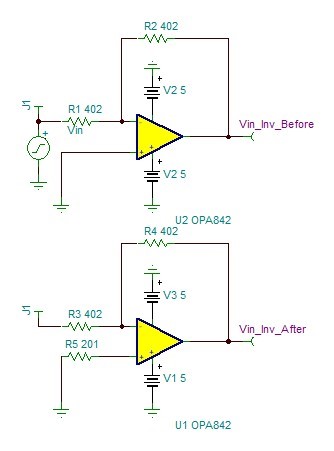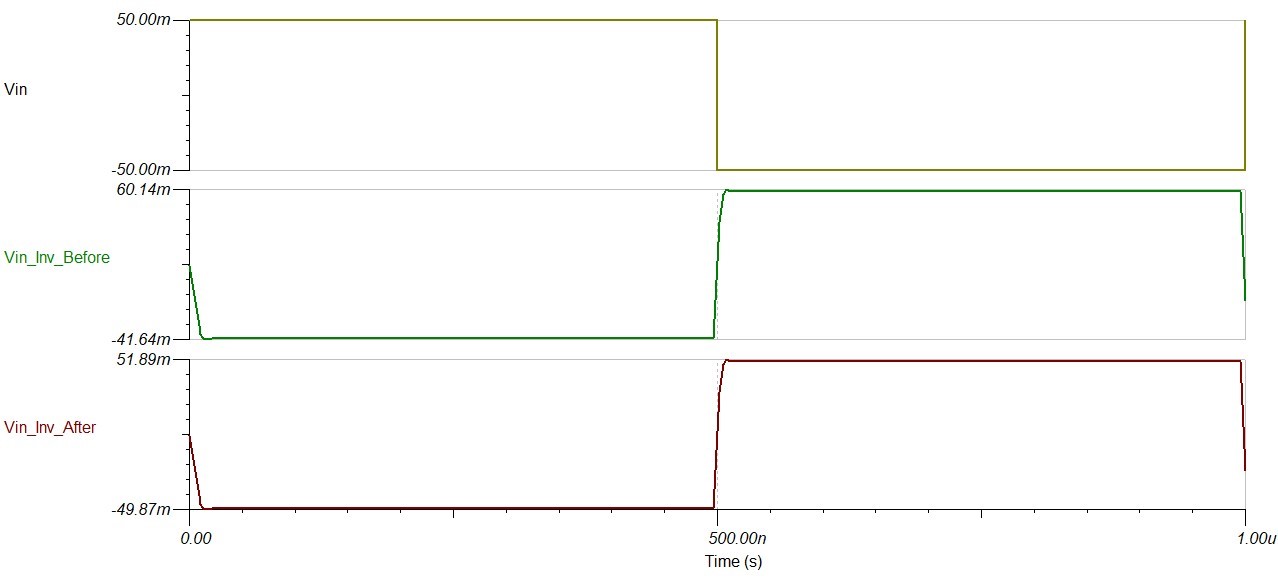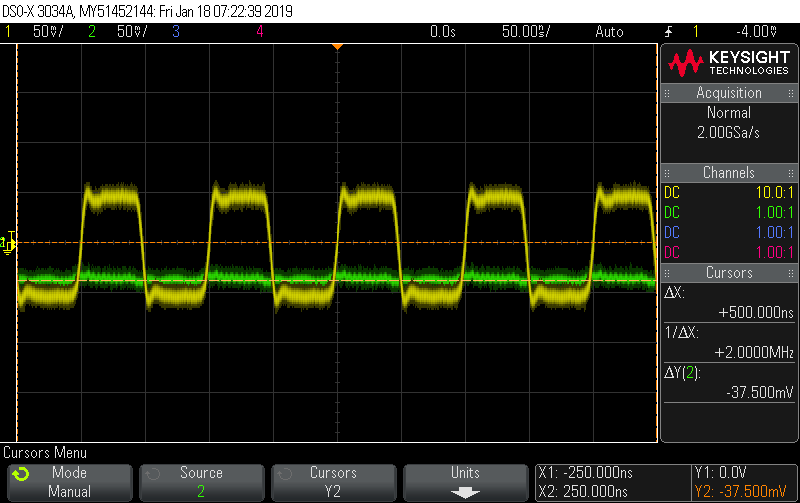Other Parts Discussed in Thread: OPA615,
Hi,
I'm trying to build a peak detector used for square wave @10MHz and the amplitude as low as 100mVpp. I followed the circuit in the OPA615 datasheet but run into the following issues:
1. The positive peak detector has a drop of ~5 to 10mV depending on the diodes being used. So far, I found that the diode JDH2S02SL gives the least drop.
2. Negative peak detector circuit is not working. I've tried both simulation and LAB. This leads to issue #3
3. So in order to detect the negative peak, I'm trying to use the OPA842 to flip the input signal (G = -1). However, I can't seem to calculate the resistor connected to the non-inverting OPA842 input. The circuit i use is also from OPA842 datasheet (datasheet circuit has a gain of -2 instead). They do mention briefly about that resistor calculation but i can't figure out how.
So my questions are:
1. Do you have any suggestions to achieve a better peak result?
2. How to calculate the resistor connected to non-inverting OPA842 when configured as G = -1?
Here's my simulation from LTspice:
PSpice models used:
*----------------------------------------------------------------------- * OPA842 Wideband, Low Noise Voltage Feedback Op Amp * Created 5/1/03 RS * * * NOTES: * 1- Uses a multiple pole-zero topology * 2- For better convergence during transient analysis set: * .OPTIONS ITL4=40 * 3- This macromodel predicts room temperature performance * (T = 27 deg C) for: DC, small-signal AC, noise, and * transient simulations * 4- This macromodel does not predict: distortion * (harmonic, intermod, diff. gain & phase, ...), * temperature effects, board parasitics, differences * between package styles, and process changes * * |---------------------------------------------------------------| * | This macro model is being supplied as an aid to | * | circuit designs. While it reflects reasonably close | * | similarity to the actual device in terms of performance, | * | it is not suggested as a replacement for breadboarding. | * | Simulation should be used as a forerunner or a supplement | * | to traditional lab testing. | * | | * | Neither this library nor any part may be copied without | * | the express written consent of Texas Instruments Corporation.| * |---------------------------------------------------------------| * * CONNECTIONS: * Non-Inverting Input * | Inverting Input * | | Positive Power Supply * | | | Negative Power Supply * | | | | Output * | | | | | * | | | | | .SUBCKT OPA842 + - V+ V- Out V_V1 V+ 10 DC 1.4 E_E3 21 22 POLY(2) 0 18 V+ V- -785m 1 0.5 E_E4 24 25 POLY(2) 18 0 V+ V- -785M 1 0.5 D_D1 16 15 DX 1 D_D3 18 20 DX 1 D_D5 23 24 DX 1 D_D7 0 27 DN1 .5 I_I3 27 26 DC 100uA I_I4 29 28 DC 100uA D_D2 19 18 DX 1 R_R16 21 V+ 45 R_R17 V- 25 45 R_R18 23 Out 5 D_D8 28 0 DN1 .5 D_D9 0 29 DN1 .5 D_D6 26 0 DN1 .5 R_R14 17 0 1000K G_G3 0 17 POLY(1) 12 11 0 50M 0 0 G_G4 0 18 POLY(1) 17 0 0 1M 0 0 R_R15 18 0 1K R_R12 15 13 75 R_R13 15 14 75 R_R10 11 10 750 R_R11 12 10 750 I_I1 15 V- DC 3.1mA D_D4 22 23 DX 1 E_E1 19 0 POLY(1) V- V+ .5 0.5 0 0 E_E2 20 0 POLY(1) V+ V- -1.0 0.5 0 0 V_V2 16 V- DC 1.5 G_G2 2 0 POLY(2) 28 0 29 0 0 .001m .001m G_G1 + 0 POLY(2) 26 0 27 0 0 .001m .001m Q_Q1 11 + 13 QN 12 Q_Q2 12 2 14 QN 11.867 I_I2 V+ V- DC 15.7mA C_C2 17 0 200p L_L5 2 - 2.46nH C_C13 0 2 1p * .MODEL DX D(IS=1.0000E-15) .MODEL DN1 D(IS=2F AF=1 KF=10.5E-17) * QN NPN model .MODEL QN NPN + IS=7.6E-18 + VAF=78.71 + VAR=1.452 + BF=157 + RB=1.20E+02 + KF=9.5E-15 + AF= 1.0 .ENDS OPA842






